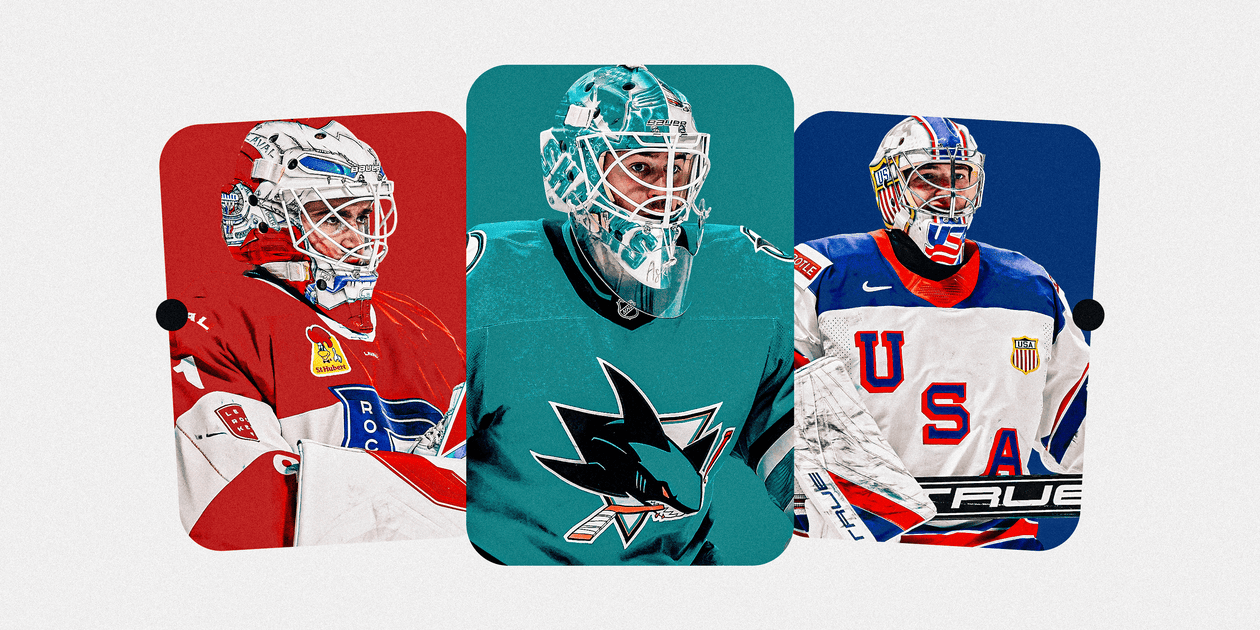Welcome to the summer 2025 edition of my drafted NHL prospect rankings at The Athletic.
This ranking of the league’s top 20 drafted goalie prospects follows yesterday’s top 100 drafted skaters list.
After publishing this project for years as one combined ranking, the move to two lists, dividing the goalies from the skaters, was made in 2020 as a response to reader demands for evaluations on a wider range of goaltenders (previously, when skaters and goalies were ranked together in a single list, only a handful of netminders normally made it). The ranking includes 20 goalies to reflect the five-to-one skater-to-goalie ratio on the ice.
To be considered a prospect, a goalie must be under 25 and not fully established as an NHL goalie. The latter qualifier is arbitrary. There, I trust my judgment for whether a goalie should be considered fully graduated more than I trust any predetermined games played cutoff. Of note, Senators goalie Leevi Merilainen is now considered a graduate.
As always, the list is also broken down into tiers and presented within our fully sortable user interface. There are three tiers in this year’s goalie ranking: 1-2, 3-18, 19-20+. I considered about 10 other goalies for that third tier.
Team BUF CAR CBJ COL DET LAK MIN MTL NJD NSH OTT PHI SJS UTA VAN VGK
Draft Year 2020 2021 2023 2024 2025
Natl. 🇨🇦 🇨🇿 🇷🇺 🇸🇪 🇺🇸
Tier Tier 1 Tier 2 Tier 3

Loading
Try changing or resetting your filters to see more.
Tier 1
Askarov has for years been one of the top goalie prospects in the NHL, and I expect this is the last time he’s featured here. He was a top goalie in the MHL at 16 and starred for Russia at U17 worlds, two Hlinkas (where he was in net for a bronze and a memorable gold) and U18 worlds (where he won a silver and the tournament’s top goaltender award). He had a .937 save percentage across three years and 16 games in the KHL as a teenager. He played 48 and 44 games to a .911 save percentage in back-to-back seasons as a starter in the AHL at 20 and 21 (he had a stretch of play last year where he won 21 straight games in the AHL and looked completely unbeatable). And last year, in 22-year-old season, he played to a .923 in the AHL and has had some impressive games in the NHL behind a porous Sharks team.
Askarov has high-end tools and legitimate No. 1 talent. His raw talent has always separated him. His ability to change directions in the net, stay on top of shooters, track their hands and make reactionary saves is elite. His athleticism is, too. He regularly makes second- and third-chance saves, holding firm in his positioning even when he’s lying on the ice, or getting back onto his toes quickly for a desperation push.
There are still times when he gets frozen over his glove hand, but he has made important progress catching pucks as a southpaw. He can look jittery in the net, bouncing on his toes and moving to pucks (which he says is to keep himself focused and make some of those quick-twitch saves I talked about) but he plays over the top of pucks in a similar hunch to Sergei Bobrovsky and some other Russian goalies and it allows him to stay engaged and active with shooters/on rebounds. His agility, explosiveness and reads are so impressive that he can steal games when he’s at his best, and make the difficult saves that others just can’t get to or stick with. There isn’t a goalie prospect in the world with quicker feet through shuffles or more explosiveness side-to-side or low-to-high than Askarov. That blend of power and speed, combined with his extended track record at a young age, gives him high upside.
Photo:
Darren Yamashita / Imagn Images
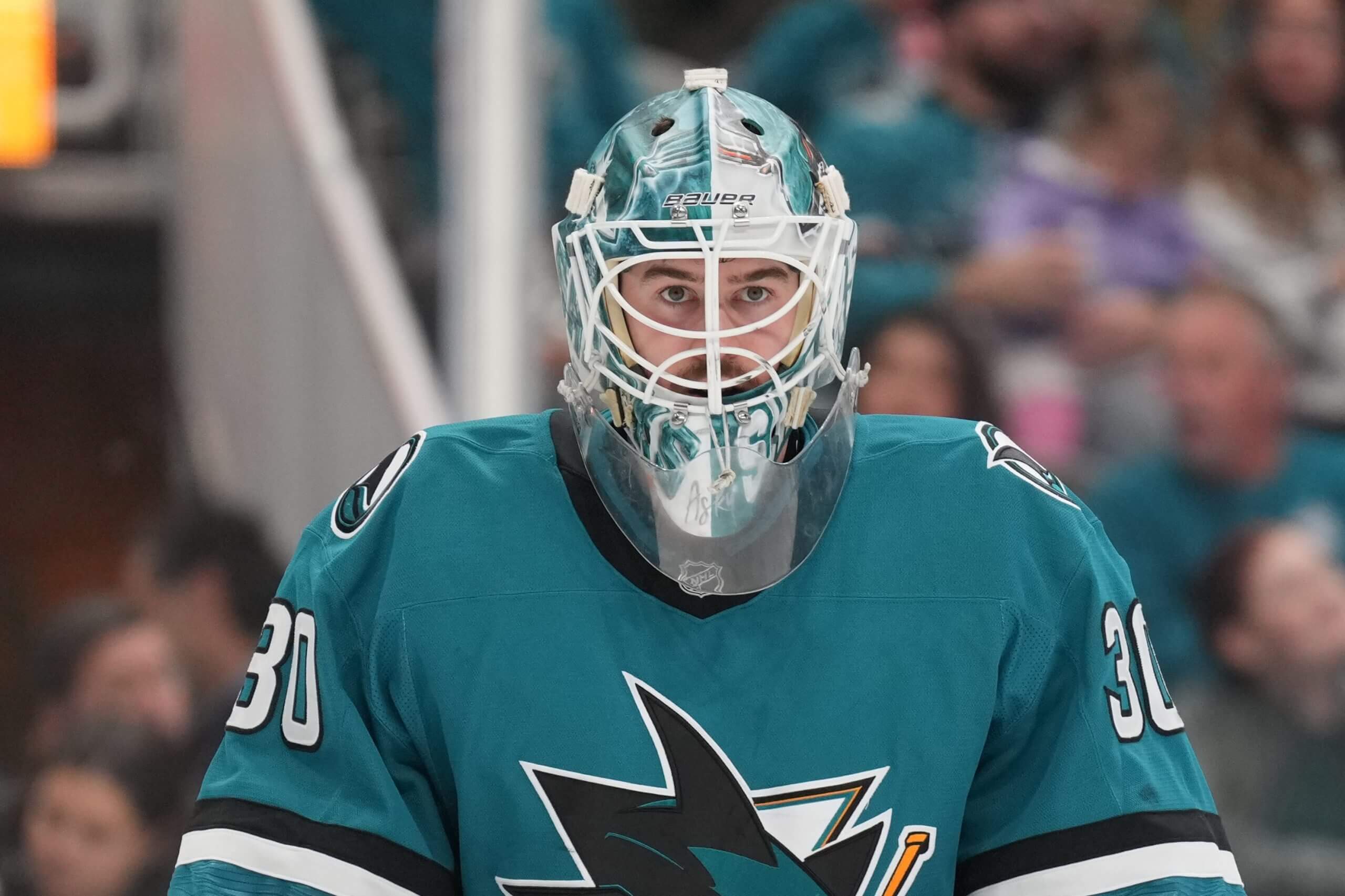

Fowler has established himself as one of the top goalie prospects in the sport with his play over the last four seasons. That started when he was named to the USHL’s All-Rookie Second Team four seasons ago and its First All-Star Team three seasons ago after leading the league in both save percentage and goals-against average. It was stamped with a stellar freshman year at BC that saw him play virtually every minute behind the top-ranked team in the country (while the team in front of him helped, their strength was most pronounced at forward, and he stole some games and was deservedly named Hockey East Goaltender of the Year). And it has been cemented last year with a repeat performance as the MVP (for me) of another top-ranked Boston College team, his save percentage rising from .926 to .940. He also had some strong performances in the AHL in the spring, even if he wasn’t able to hold the Laval net in the playoffs as a rookie. (I should note that I’ve seen him look just OK with Team USA both in Gothenburg at the World Juniors and Plymouth at the World Junior Summer Showcase, but he was also excellent at the World Jr. A Challenge and the body of work over the last four years is unimpeachable.)
He’s the kind of goalie who, if he can see a shot and move to it, is going to stop it.
He had some work to do on some other things (conditioning/fitness, less business on scrambles, losing his posts at times) pre-draft but he has worked hard at it and is by all accounts committed to staying in better shape (he’s now listed between 210-220 pounds and there has been progress off the ice), and has so many clear tools, highlighted by great hands, an ability to take space away through square angles and sound positioning, high-end tracking/reads, excellent rebound control, legitimate power/movement and a knack for making huge pad saves and stopping high-danger chances. He rarely gets beat through the body or frozen. He doesn’t show holes in the net and has the reflexes to get a piece of (or a hold of) pucks when he does. He has a legitimate shot not just to be an NHL goaltender but to be a top one, and there aren’t many goalies his age (or even a little older) I’m comfortable saying that about. He seems to pitch a shutout once or twice a month these days and I though he had a compelling case for the Hobey Baker last year and was hurt by some of the conference allotments/politics of the nomination process (which was evident when he wasn’t a top-10 finalist and still won the Mike Richter Award as college hockey’s top goalie).
Photo:
David Berding / Getty Images
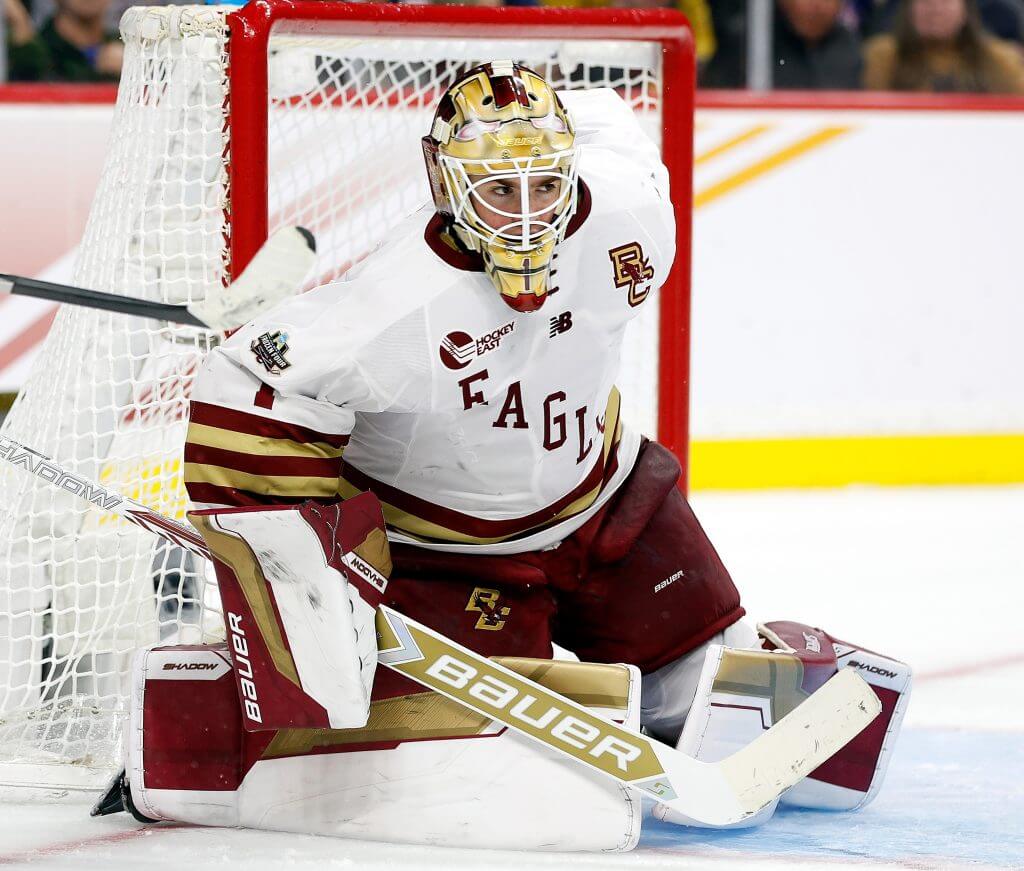

Tier 2
The definition of calm, cool and collected, Augustine is the best goalie prospect to come through the national program since Spencer Knight (I like him more now than I liked Blackhawks goalie prospect Drew Commesso at the same age, for example). I’ve seen him play a ton over the years and I’ve always been impressed by his composure and the consistency of his play, whether that was in Plymouth with the program, Germany and Switzerland at two U18 worlds, Halifax, Gothenburg and Ottawa at three World Juniors (and twice in the net for gold) or a trip to East Lansing. After a strong freshman year with the Spartans, he was even better for them as a sophomore last year (his save precentage rose from .915 to .924) and has been a big reason for their revival as a top program.
He’s dialed in, by all accounts just as much off the ice in the way he carries himself and goes about his business as on the ice, where his game has rare detail and intellect for a netminder his age. He’s good moving on his knees and in a crouch. He’s good at tracking pucks through traffic and across ice on seam plays. He plays good, sharp angles. His rebound control, steering pucks into the corners, is good. He’s good at getting down into his butterfly to close his five-hole quickly. He has good control generally. He’s as good in the lower third as any goalie his age, kicking pucks into the corner instead of out into the slot, and sticking with dekes and five-hole plays. His athleticism is there when he needs it. He’s stoic. He’s just a good goalie.
While he’s not big for a goalie (he’s listed at 6-foot-1 and 190-something pounds, up 15 pounds from a year ago) and he can occasionally get frozen glove side or drop pucks into his glove, he’s a goalie I have a ton of confidence in projecting to have a good pro career. He doesn’t have obvious starter talent or size, but I could see him getting there (or at the very least becoming a solid, reliable tandem goalie). I’d trust him to play for my team and remain even-keeled any day. He and fellow Red Wings goalie prospect Sebastian Cossa are such different people and goalies as well, which will make for an interesting yin and yang dynamic, I think. But I’m a bigger believer in Augustine and believe has has already passed — or will pass — Cossa on their depth chart.
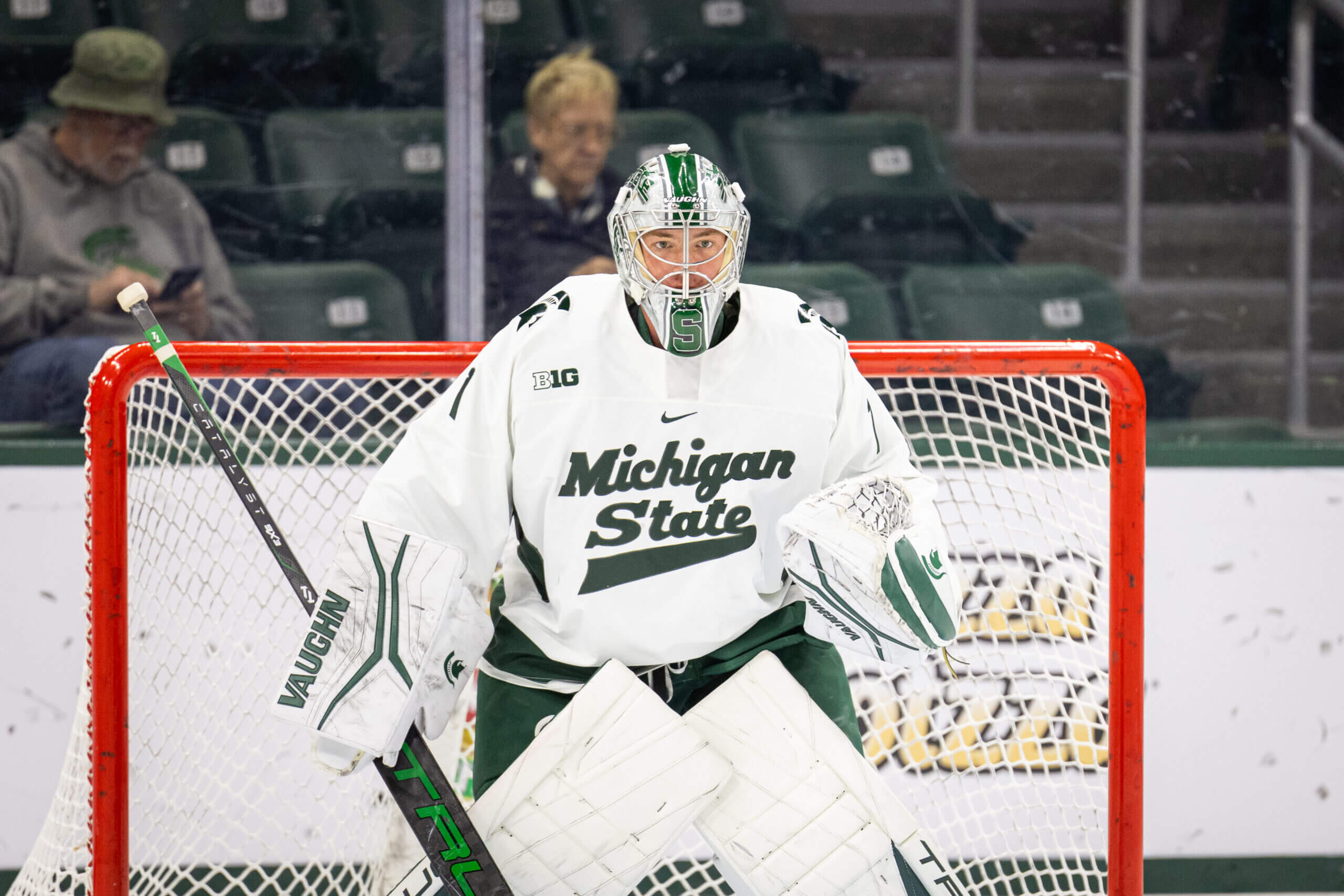

Yegorov is a freak athlete who wowed some people at the combine in advance of the draft and has high-end attributes. He’s a 6-foot-5 goaltender with raw, natural athleticism that presents itself in his ability to go post-to-post or low-to-high. He’s also got good hands, and he reads and anticipates the play smartly. He started his post-draft season by returning to the USHL with the Lancers, a team in disarray that often got shelled with shots. After posting a .912 save percentage across 19 games and just three wins to show for it, Yegorov accelerated his commitment to Boston University and joined the Terriers for the second half (where he was excellent early and into the Beanpot, and really made a world of difference for that team, elevating its ceiling and backstopping BU into the Frozen Four). Yegorov was one of the stories of the college hockey season (the five goals he gave up in the final were the most he’d surrendered after joining the Terriers). The talent is all there. He’s a big, long, lean goalie who should get stronger, is quick on his feet and in and out of his butterfly with clear technical skills as well. With the right patience, there’s some serious untapped potential in Yegorov’s game that should continue to reveal itself.
Photo:
Dilip Vishwanat / Getty Images
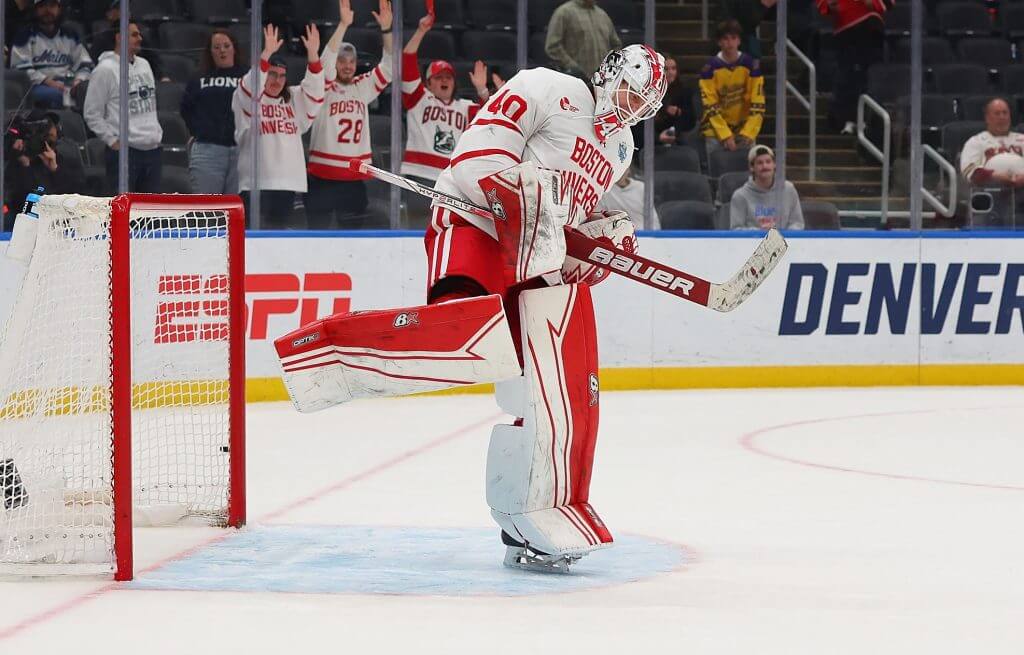

Ravensbergen was one of the stories of the WHL season two years ago. He was undrafted into the WHL, pitched a shutout in his first start and emerged to challenge Canucks draft pick Ty Young for starts in the regular season with Prince George, playing to an even split and then winning the net in the playoffs, where he was outstanding (his .931 playoff save percentage set a new WHL benchmark for a rookie goaltender). That play, combined with his 6-foot-5 frame, earned him an invite to the World Junior Summer Showcase from Hockey Canada and made him the consensus top goalie prospect in the draft entering last season. However, he dealt with a hip injury that limited his training in the offseason when he could have really used some time in the gym to get stronger (he has never really worked out and is quite lean). Last season, he was good without putting up typical first-rounder numbers, playing a lot to a save percentage just above .900 after a strong start to the year (he had a couple of off games early in Prince George’s first-round loss to Portland as well but played really well in Games 5 and 6 to force a Game 7).
Ravensbergen is a rare southpaw as a right-catching goalie (coincidentally, as is fellow Sharks prospect Yaroslav Askarov). He moves very smoothly in the net for his size. He’s smart in his reads and anticipation. He can go post-to-post or low-to-high to get to difficult saves with his length and has definite room to get more powerful through his pushes. He has a competitive fire. He reads the play well and fills the net to take away options from shooters with sharp, challenging angles. He has some natural standout attributes and the size to match. I’ve seen him look vulnerable, or get frozen, or give up low-danger shots through his body (including at the WJSS, where he wasn’t at his best), though, as well. His upside is real, though, and there is untapped potential in his game if he can get into the gym and really build up his body. The tools are all there. That’s what the Sharks are betting on. I did think about ranking him a little lower here, though.
Read more in our feature here.
Photo:
James Doyle / Prince George Cougars
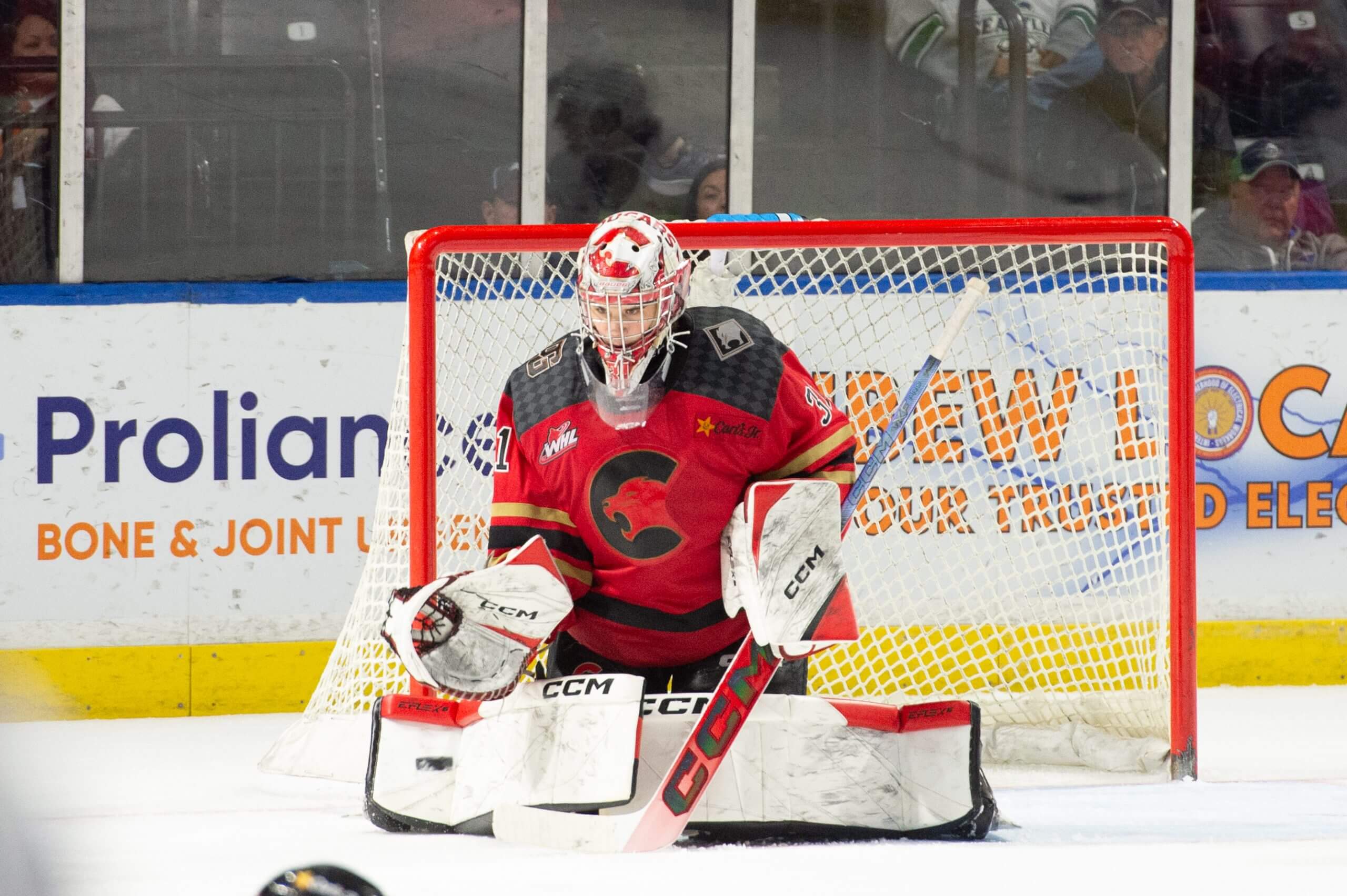

I believed there were a handful of legit goalie prospects in the 2025 draft, and Andreyanov was firmly No. 2 for me. The 6-foot, 207-pound Russian might lack ideal height, but he fills the net for his size and looks heavy and powerful between his posts without his weight slowing down his footwork and mobility. He’s a strong, sound goalie with good hands and technical ability who tracks and anticipates well, competes and can stay square to swallow the first shot or go post-to-post to make more difficult saves. He has good hands, tracking and reflexes. He’s comfortable playing the puck. He had some big performances this season and looks like a stud to me. Andreyanov gave up more than three goals just twice this season: A 6-5 shootout win where he made 52 saves on 57 shots, and a 4-3 playoff loss where he stopped 41 of 45. That’s remarkably consistent, even in the MHL, where save percentages tend to skew higher. I believe he has starter upside.
Photo:
Maksim Konstantinov / Getty Images
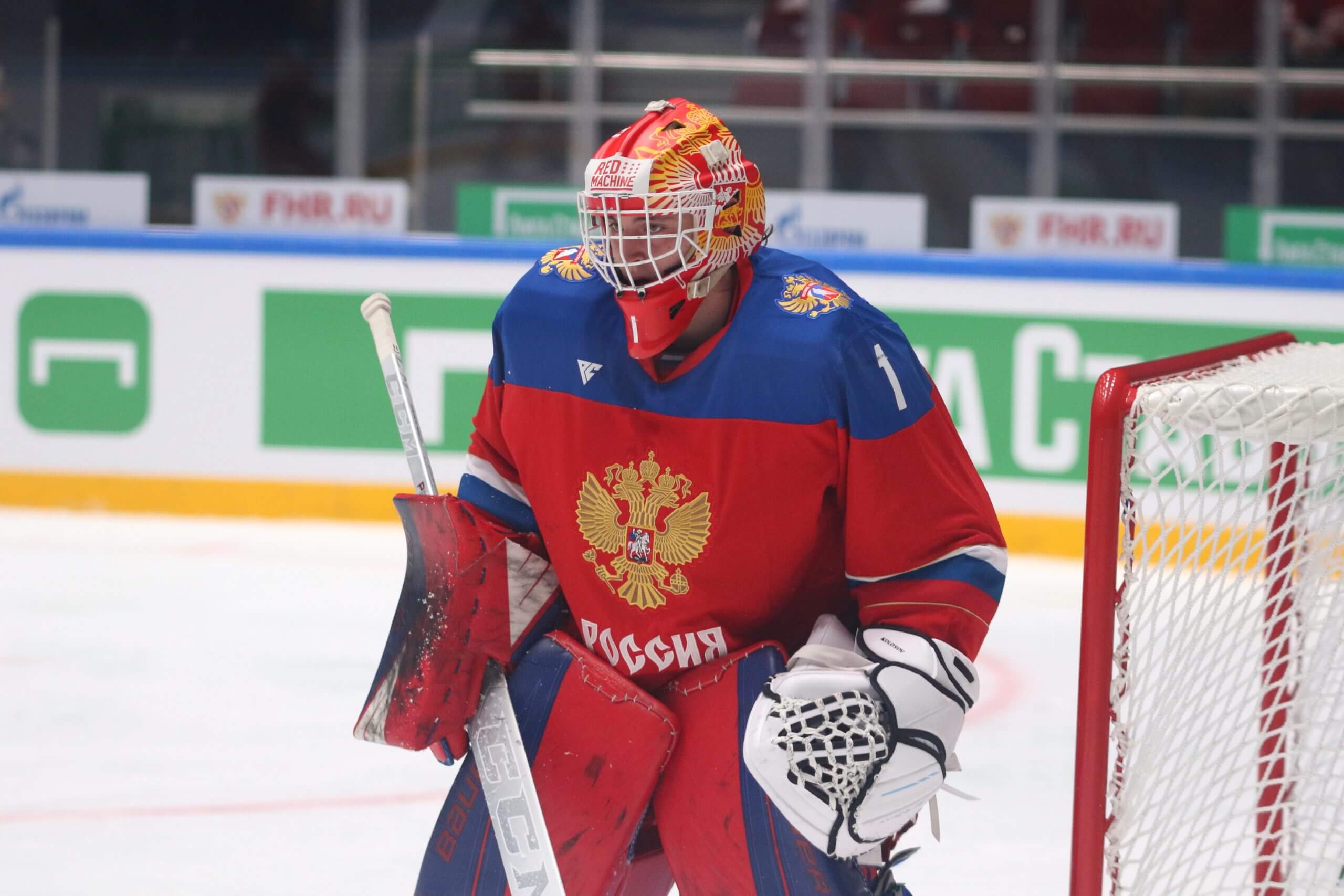

Levi’s numbers as a rookie in the NHL over parts of the last three seasons (a .894 save percentage) haven’t lived up to the pedigree that preceded them, but his play in the AHL has matched his track record (.927 and a hugely winning record two seasons ago, and .919 last year). While I’m in the minority, I still believe he’s going to become a better NHL goalie than Ukko-Pekka Luukkonen. Levi had two seasons for the ages at Northeastern, winning the Mike Richter Award as college hockey’s top goalie in back-to-back years as a freshman and sophomore, and finished his college career with a .942 save percentage (while mixing in three appearances at three different levels for Hockey Canada). His journey from the CCHL to the World Juniors and then the Olympics, all during the pandemic, was one of the best stories in hockey for a little while. He’s still young by goalie standards and has played very well in the AHL across a larger sample there than his NHL one.
He has pretty much exactly the skills smaller goalies (he’s listed at 6-feet and 192 pounds) need to be successful. Impressive control on his inside and outside edges, and the patience to hold them. Quick feet on his shuffles so that he can stick with dekes and go post-to-post or low-to-high to get to tough pucks. Good hands. Excellent reads on shooters. Excellent tracking through and under traffic. And a battler’s mentality in the net, which keeps him in plays even when he looks like he’s down and out. There still aren’t a ton of 6-foot goalies in today’s NHL, at least not starting ones, but I still believe that Levi can follow Calgary’s Dustin Wolf to become one, though I don’t think he’s at Wolf’s level. I did think about ranking him a little lower here but I’m going to hold firm in my belief in Levi.
Photo:
Jayne Kamin Oncea / USA Today
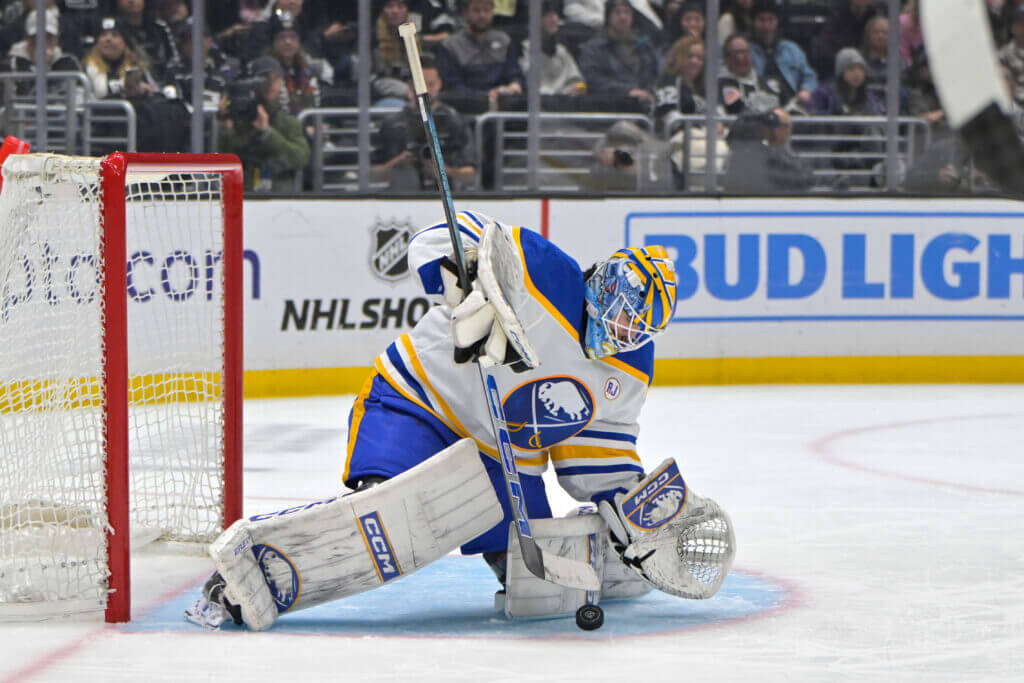

After a positive season in Grand Rapids two seasons ago, making important progress in some important areas, Cossa had some ups and downs last season, playing to a very high level behind a Central Division-leading Griffins team in the first half but just OK in the second half and in the playoffs. He’s a huge (6-foot-6), powerful, athletic goalie, and those last two things don’t always come with the first. He’s also a fiery, confident, talkative competitor who doesn’t like to get beat (which contrasts with the stoic demeanor we see in many goalies) and wants to command the net and the room. Bigger goalies often struggle with their movements and their recoveries, but neither is an issue for Cossa. His positioning (he does a good job holding his outside edges to be patient on shots) and reflexes (he has great hands up high) help him block and grab a lot of pucks. But it’s his ability to bounce back into his stance or change directions with passes that separates him for a goalie as tall as he is. His power through his pushes gives him a rare side-to-side ability for a goalie that big.
There have been times over the years when I’ve seen him look leaky and really struggle to close his five-hole because of his size (this remains a bit of a recurring issue, though it has improved, and he does a really good job kicking pucks aimed for the lower corners). He’ll still occasionally lose himself in his net on scramble plays, as those strong pushes to get to tough lateral saves can pull him off his lines. He can get pulled out of his net overcommitting on dekes. But he has worked to settle down in each of those areas (his habits still need to be more consistent), and his natural gifts give him undeniable upside. When he’s set and square to shots, he’s tough to beat. I’ve seen him look unflappable and make point-blank save after point-blank save when he’s dialed in. I’ve also seen him look rattled as shots sneak through holes they shouldn’t be finding. I still think he has upside due to his combination of size, dexterity, competitiveness and explosiveness in the net. But he’s still got work to do as well.
You’ll notice I did move him down a tier here, though he’s still ranked high on the whole.
Photo:
Jamie Sabau / USA Today
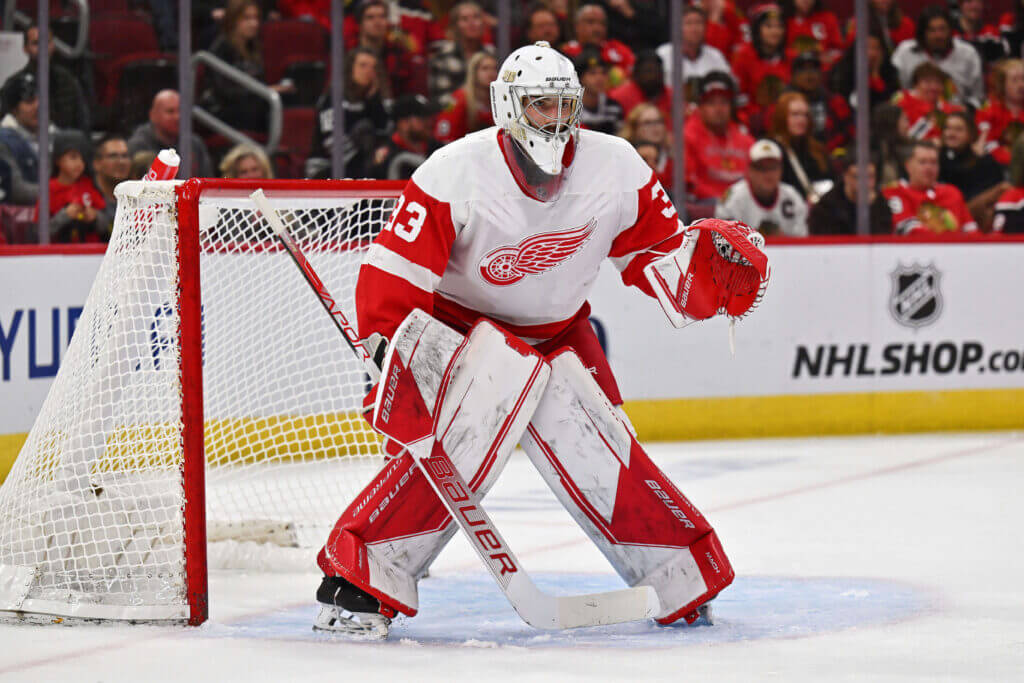

Early on three seasons ago, when Hrabal arrived from Czechia’s junior league and took the USHL by storm, putting up gaudy numbers through September and into early November, there was first-round buzz about him. Here was this massive 6-foot-6/7 goalie with an impressive early track record. Then he hit a rut into the new year and lost his job for a spell, only to regain form in March and April, both down the stretch with the Lancers and then as one of the top three players on Czechia at U18 worlds, where I thought he was mostly excellent. Two seasons ago, as a freshman at UMass, he was mostly good as well and finished with a .912 save percentage, although his first World Juniors was more of a mixed bag (he was great in Czechia’s upset win over Canada but also had some really rough moments, giving up a number of bad goals). Last season, after a summer of good training, Hrabal began to realize all of his potential, playing to a .924 save percentage as a sophomore at UMass and leading the Czechs to another bronze medal at his second World Juniors with a better tournament that included a huge performance in the bronze medal game (and its IIHF record-long 14-round shootout).
The size jumps out at you right away, but there are layers, good and bad, to the rest of his game. Hrabal gets down into his butterfly a little slowly, opening up his five-hole for shooters (a common problem for bigger goalies), though he has made progress on it this year. Once he’s on his knees, he actually scrambles well for a goalie as tall as he is. His hands (both glove and blocker) need some work up high, and he has an odd tendency to try to catch low shots instead of making a pad save; I suspect it’s because he doesn’t trust his rebound control on quick shots. I’ve seen him look completely in command, fill the net and take everything away from shooters. I’ve also seen him get beat cleanly and look like he’s not tracking pucks. I would like to see him work on playing the puck as well. The upside is hard to ignore, though, and he has some real natural ability and a game-stealing quality when he’s dialed in, sharp on his lines, square to shooters and on his toes. Fewer shots are sneaking through his body, and his competitiveness and size are a good combination. He has also developed more and more power to his game, with more that will come as he continues to fill out his frame (though he’s now listed at around 215 pounds, he still looks wiry), and he moves well for his size and can really take away a shooter’s options when his angles are on point. I’d bet he turns pro after his junior year in college, and if he can continue to be patient I think he has real NHL upside.
Photo:
Minas Panagiotakis / Getty Images
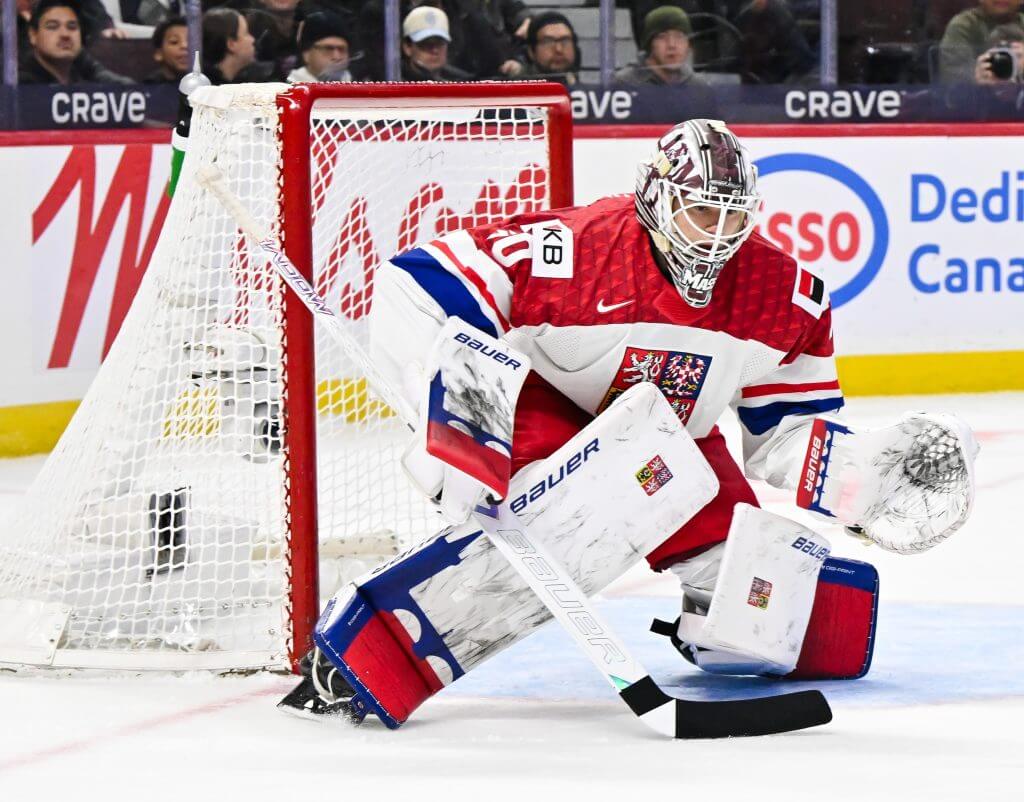

Ivankovic is a small but top-end goalie who has played at a consistently excellent level for Hockey Canada and the Steelheads and has the high-end tools across the board that you look for in a 5-foot-11/6-foot netminder. He plays an incredibly calm, controlled, positional style, especially for an undersized goalie, staying square to shooters, getting set early, holding his edges and controlling his rebounds so well it can look like he’s not moving in the net (and when he does move too much and loses his posts, he battles to get back into his spots and get to pucks on scrambles). His goalie IQ and anticipation are elite. But he’s also ultra-competitive, mobile and athletic, fighting for pucks in the crease and regularly getting to pucks he shouldn’t. Add in strong puck-playing ability, excellent hands and dexterity and dialed-in tracking, and you’ve got a goalie who consistently steals games. Despite being smaller, he’s also great down low and up high, staying on his feet long enough so that guys can’t pick corners on him but also quick to drop down and kick out pucks.
Ivankovic is a very impressive goalie and while his save percentage last year (which hovered around .900) didn’t look glossy and he wasn’t great in the playoffs for the Steelheads, I thought they struggled in front of him and the Oshawa team they played in the first round had a lot of firepower. I believe in him as a future NHL goalie. He was head and shoulders above all of the other goalies at U18 worlds this year. The 27 stops he made on 29 shots in the two U Sports games (.931, the best in camp) at Canada’s World Junior Selection Camp also aren’t included in his data, either. Plus, there’s at least some hope he’ll get an inch or two and have a late growth spurt (he wears size 12.5 shoes and his dad, Frank, is 6-foot-5). I’m a believer and really liked the pick for the Preds.
Read more in our feature here.
Photo:
Charles Warburton / Brampton Steelheads
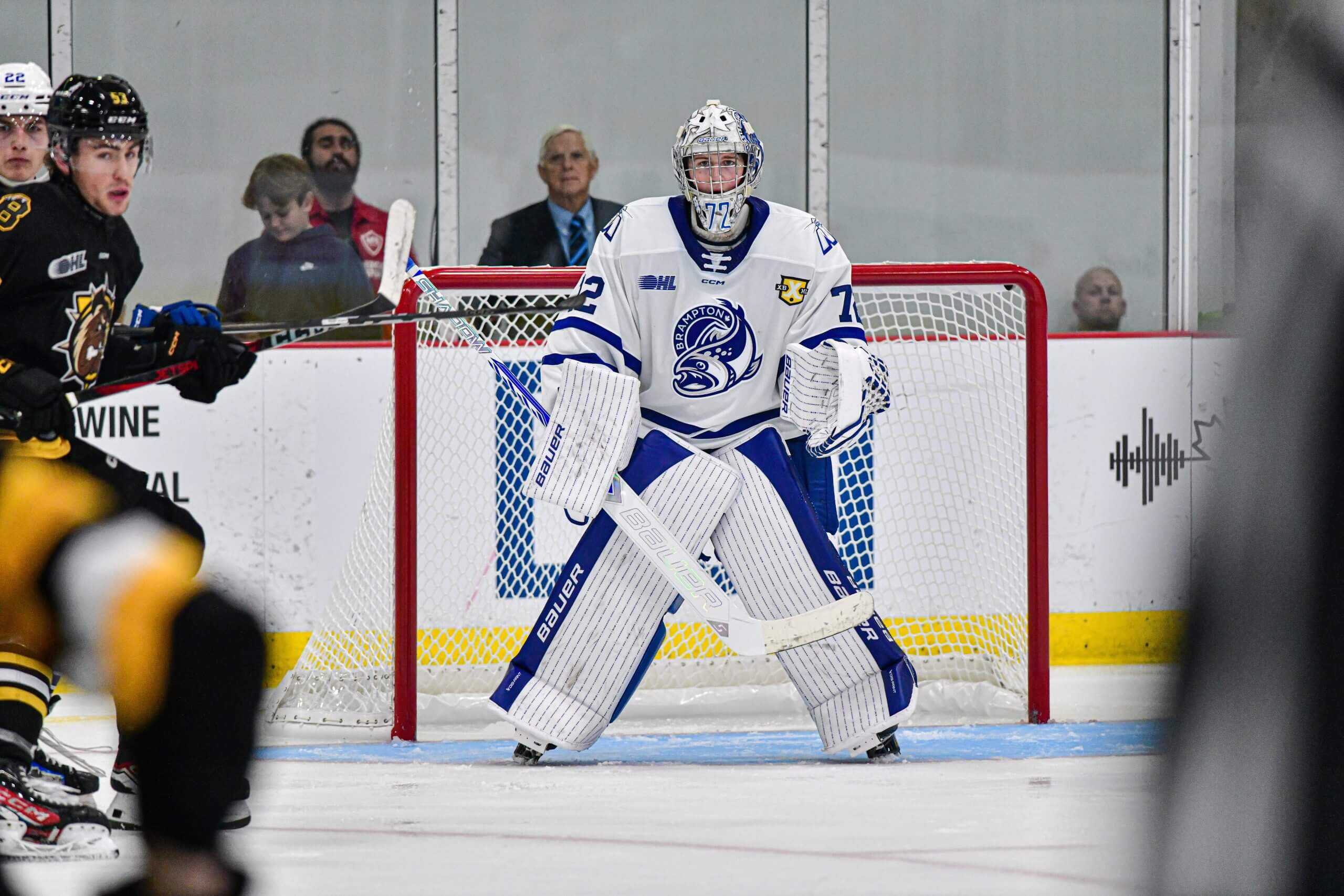

Nabokov was my top-ranked goalie in the 2024 NHL Draft and the first goalie chosen, and has established himself as one of the top goalies outside the NHL over the last couple of years. He doesn’t have ideal size (though I wouldn’t call 6-foot-1 small, either) but was an MHL All-Star three years ago and has been one of the best goalies in the KHL the last two seasons, winning the rookie of the year award and then KHL playoffs MVP after he backstopped Magnitogorsk to a Gagarin Cup title two years ago and following it up with another excellent season last year (he now has a career .926 save percentage across 93 KHL games and an even better .938 in 28 playoff games). He’s a mobile and extremely technically and positionally sound goalie who gets to pucks, recovers quickly, sticks with scrambles and tracks well through traffic, but also stays controlled, is competitive, and has good hands. I don’t see much to pick apart in his game, and I expect him to be really solid as an NHL goalie. I thought about ranking him a couple of spots higher here.
Photo:
Maksim Konstantinov / Getty Images
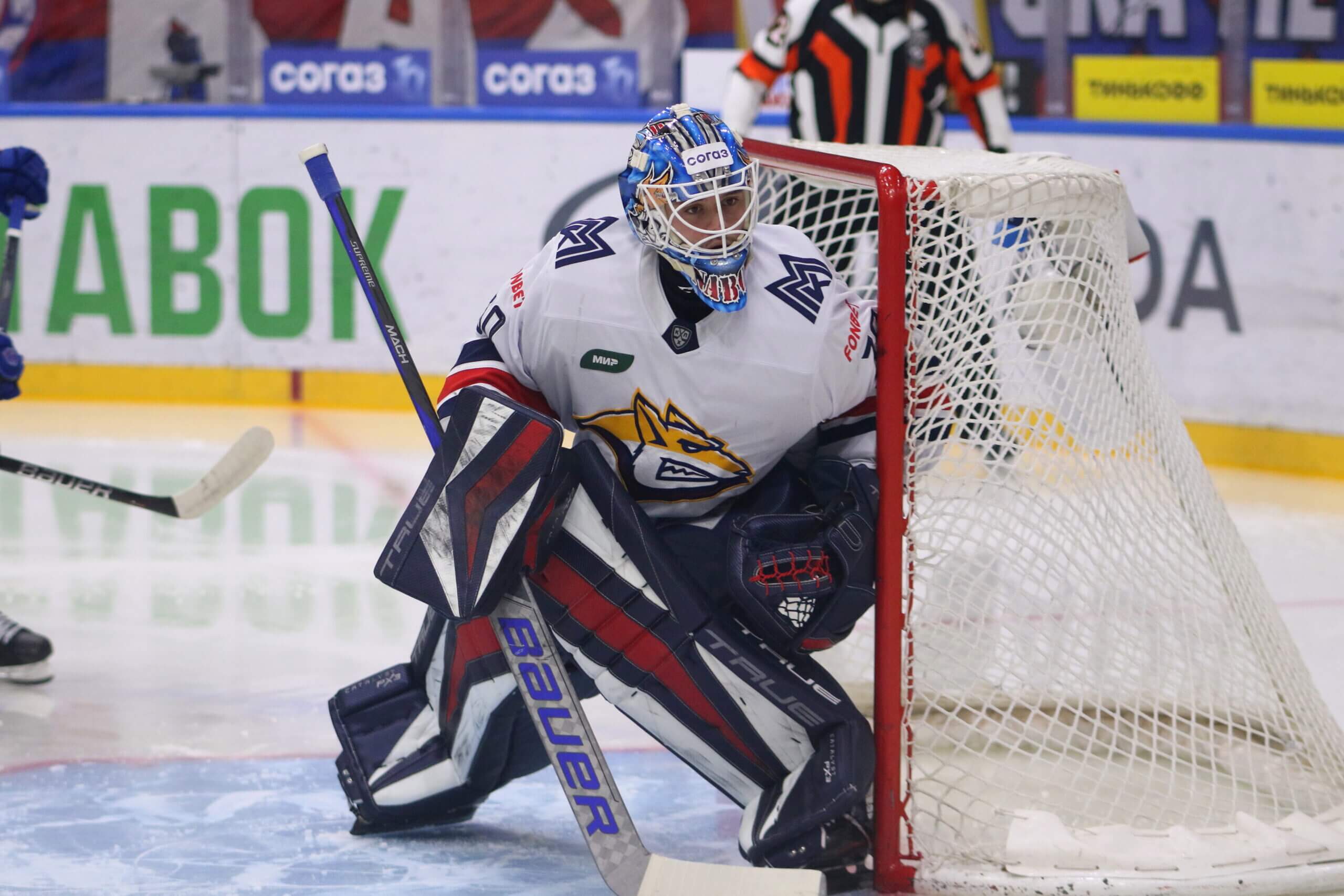

Last season was the first really challenging year of Wallstedt’s young career. He struggled with injury and poor play, losing his game and frankly not looking like himself in stretches. And while Iowa really struggled to keep the puck out of its net and defend in front of him, the Wild were also a porous defensive team the year prior, and he still managed better that year. (Two years ago, his .910 save percentage versus veteran partner Zane McIntyre’s .881 said as much. But his .879 last season also said the opposite, even considering the context of the team and his health.)
The reality is that Wallstedt, whom I talked about for years as a goalie robot, looked human last year. His body of work and game still combine to make him a legit goalie prospect, but there are some areas revealed to need work, and this ranking is now really counting on him bouncing back and regaining form.
Wallstedt’s game has traditionally had polish and maturity in lots of areas (it’s important to remember that even though last year was already his third AHL season, he was still one of only about a dozen U23 goalies who played regularly in the league). There’s a control and soundness to his game that was always rare in goalies his age. He’s also a big 6-foot-3, 213-pound (he fills the net, too) goalie who plays sharp lines positionally, holds those lines and swallows the first shot so that he doesn’t have to make a ton of second saves. He’s shown a calmness in the net over the years, staring down shooters and reading them. He covers the bottom of the net well and kicks and controls pucks well down low. He tracks through layers well to find pucks, and he reads opposing shooters so well that he’s rarely beaten cleanly. There are some minor questions about his fitness and his agility, though. There are times when he doesn’t get up and down as quickly as you’d like to close his five-hole or recover on second and third chances. And while he’s strong going post-to-post and low-to-high, I wouldn’t say he has quick feet one-on-one. I still believe he can become a good 1A/1B, but he does need to get a little quicker if he’s going to realize that potential. If he has another season like last year’s, I’ll have to downgrade his projection and slotting further, but I’m betting he has a solid year and regresses to his mean.
Photo:
Jerome Miron / USA Today
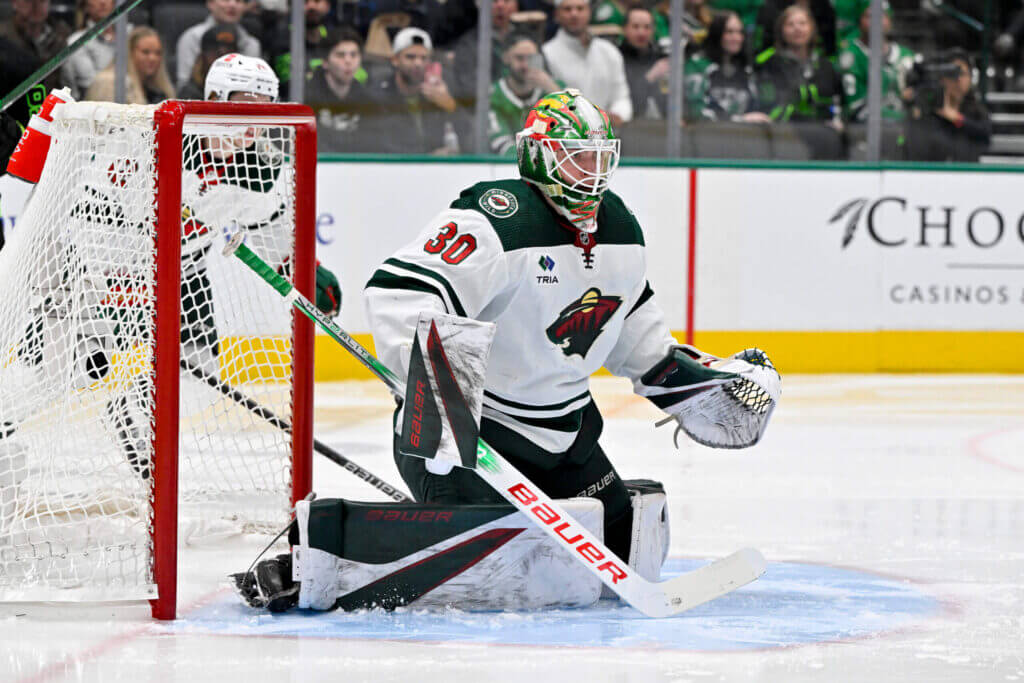

Slukynsky has taken a unique path for a goalie through Minnesota’s high school circuit to the USHL and now Western Michigan, and along that path he’s played for virtually the best team at every level: Warroad, then USA Hockey, then Fargo, then a natty-winning Western Michigan team in a tandem as a freshman last year before emerging as the starter into the conference tournament and the Frozen Four. A lot of that has to do with him, though, too — you don’t win every game you play by accident, even with a better team than the opposition. His numbers did take a hit at the World Junior A Challenge where USA wasn’t the clear-cut best team, but he performed well again with the USA jersey on at last year’s World Juniors, making 42 of 45 saves (.933) in games against Latvia and Switzerland and finished his freshman year in the NCAA with a .922 save percentage. He was also the goalie named to the All-Tournament Team at the Frozen Four in St. Louis. His track record stands on its own.
He’s a lean goalie but has grown from 6-foot-1 and 179 in his draft year to 6-foot-2 and about 185 now. Slukynsky is a very smart, anticipatory goalie with legitimate quickness and mobility in the net. He stays square to shots and hits his spots early. He’s active and fast on his feet, athletic with good hands, sticks with shooters one-on-one, gets to his spots early and tracks well — most of the boxes you look for! He needs to get stronger to hold the crease better on jam plays, but that’s been my only criticism of his game. Despite his glossy record over the years, I’ve also seen him steal a lot of games with his mobility and talent. With some added strength, I think he’s going to be a good NHL goalie.
Photo:
Michael Miller / ISI Photos / Getty Images
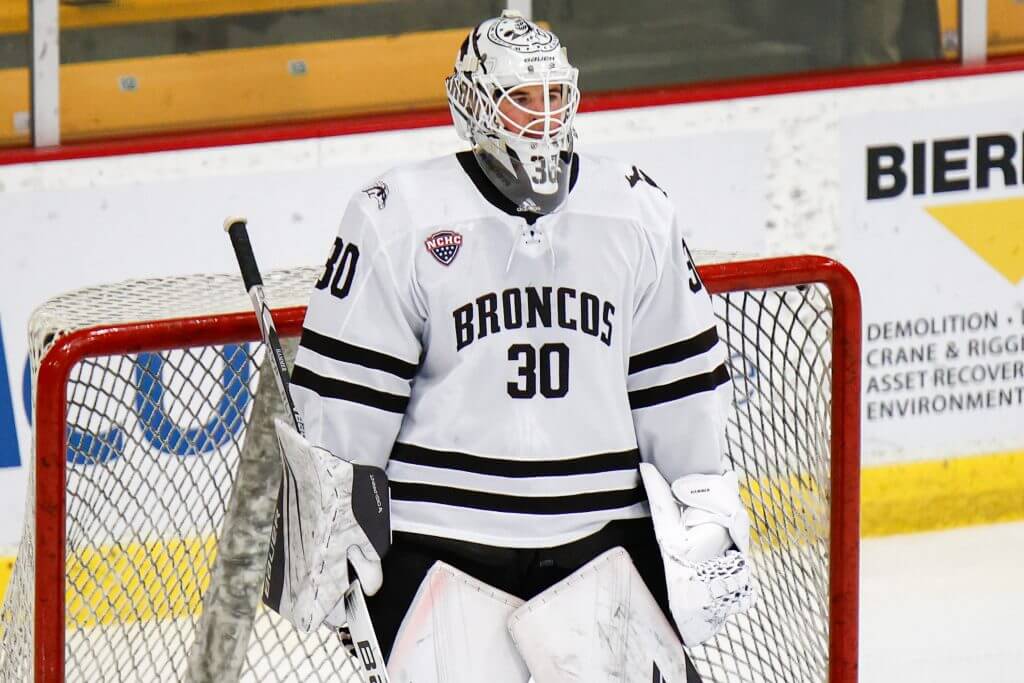

George is a goalie I have a lot of time for, and I debated making him my top-ranked netminder in the 2024 draft before placing him second behind Ilya Nabokov. He made more saves than any other goalie in the OHL two seasons ago, was consistently good across 56 games for Owen Sound, performed well as a 16-year-old in splits between the OHL and GOJHL three years ago, played well at the CHL/NHL Top Prospects Game and was one of — if not the — biggest reasons Canada won gold at U18 worlds. Last season, he was good (better than his .909 save percentage, which is still good in the OHL these days) behind a bad Owen Sound team, was very good for Canada’s disappointing World Juniors team, stopping 102 of 109 shots across four games (.936) and surrendering just two of those seven goals at five-on-five, and was really solid in his first two pro games in the AHL with the Ontario Reign. You get the picture. He’s just a good goalie.
George doesn’t have ideal size, but he’s big enough (6-foot-1 and 190) and rarely seems to get frozen straight up with shooters because he has good hands. He knows when to stay on his feet and when to get down and pick pucks out, because he reads it so well off the blade, and he’s patient. He’s very communicative and shows comfort playing pucks. He tracks pucks through traffic really well. He has quick feet and closes his five-hole fast, with mobility moving laterally and correcting.
George plays a positionally sound and calm game for his age that shows a lot of maturity. He’s not super explosive, but he’s a smart, quick, competitive, consistent goalie who should have a long pro career and has the calm, studious demeanor you look for.
Photo:
Natalie Shaver / OHL Images
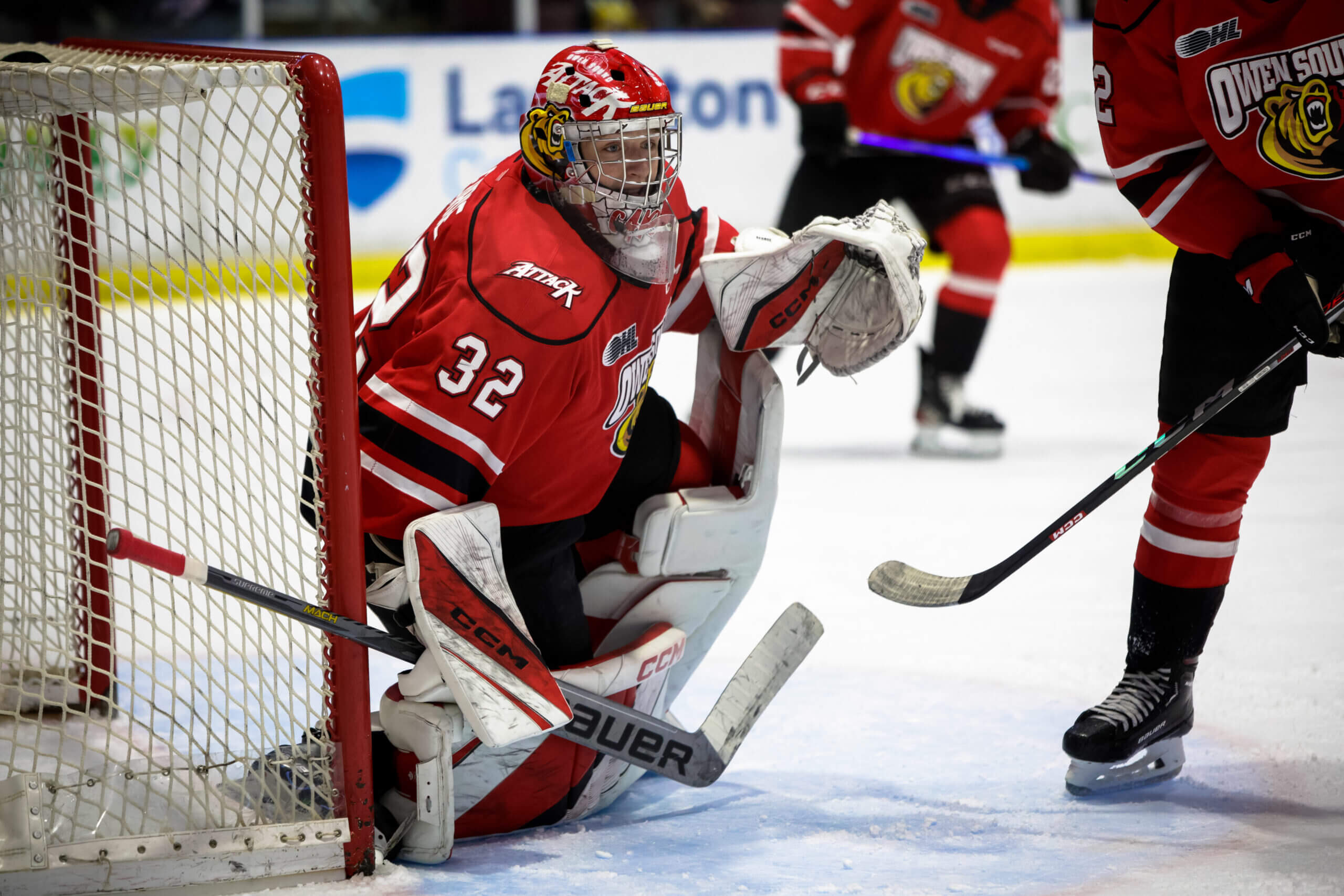

Medvedev, the OHL’s First All-Rookie Team goalie last year, was one of the breakout stars of the 2025 draft class in the first half, playing to excellent results as a rookie with the Knights before veteran tandem mate Austin Elliott grabbed the net in the second half and into the playoffs and wouldn’t lose/give it back. Medvedev was 5-foot-11 when London drafted him in the second round of the 2023 OHL draft, and after spending his 16-year-old season in the Jr. B GOJHL, he’s now over 6-foot-2. He moves well, is competitive on second and third chances/scrambles, and while he plays behind a top team, he has been consistently good for them. I have found that he can play a little deep in his net and look small with the bit of a hunch that he has (a hunch over his toes that a lot of Russian goalies have as their stance), but he makes up for it with his quickness, talent and good hands. He’s also, by all accounts, a really hard worker. There were some who believed he was the second- or third-best goalie prospect in the 2025 draft, and he looks like a legit prospect and has a lot of the tools you look for in a goalie. He’s also very young (he was just days away from being eligible for 2026), which has some excited about his continued development.
Photo:
Luke Durda / OHL Images
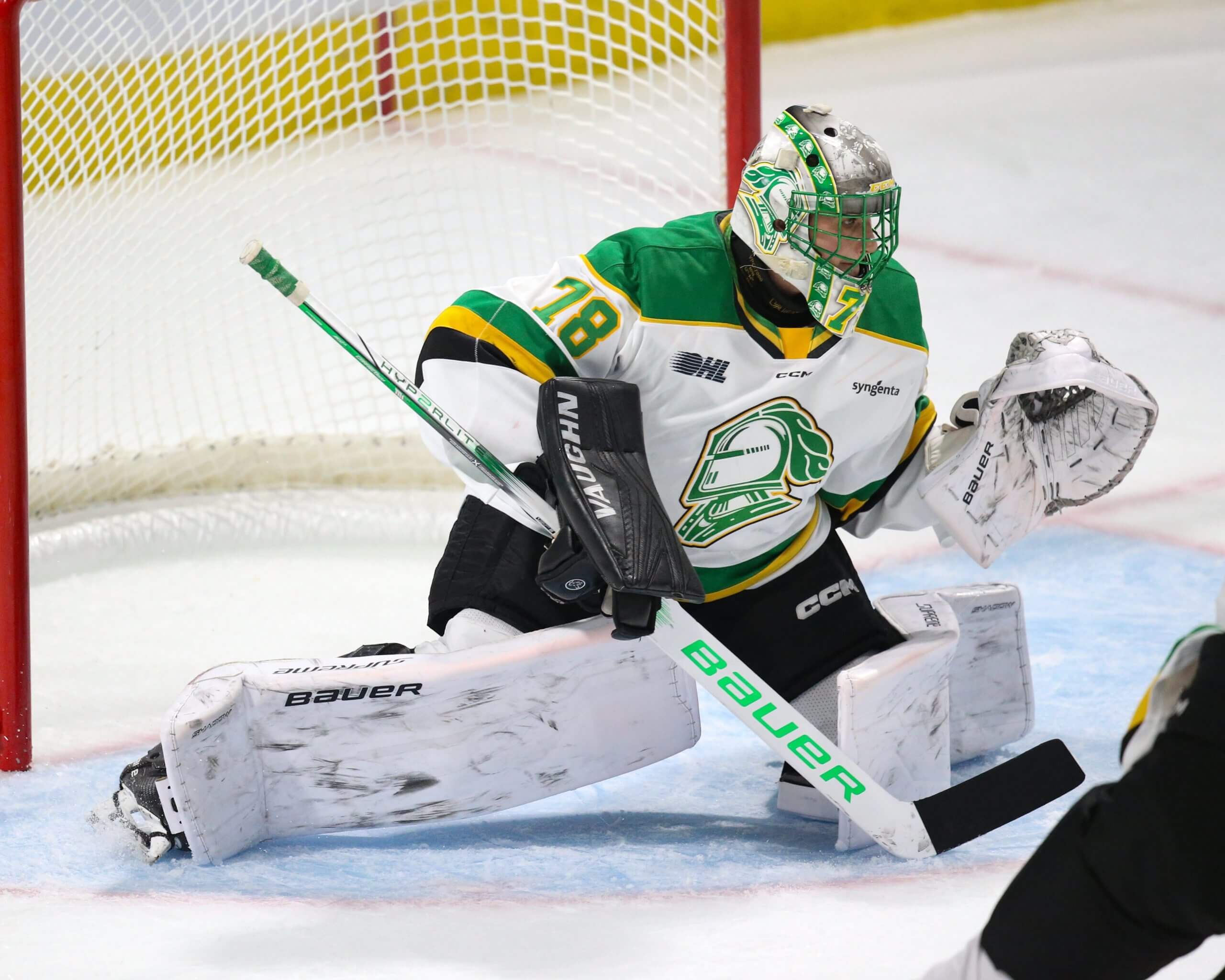

NHL Central Scouting’s No. 2-ranked European goalie, Frolov is a good-sized goalie who has a .916 save percentage across 49 games combined regular season and playoff games in the MHL over the last two seasons. He plays an aggressive and challenging style; when he’s on, shooters struggle to beat him or even create rebounds off him straight-up because he takes away their options, stays on top of them and then has good hands up high and is quick to close off and seal the ice down low. He plays on his toes and makes the first save consistently. He can get a little scrambly and lose his net on second and third chances, though, and can sometimes be a little overzealous. I like the size, ability and confidence he plays with. He clearly trusts himself to beat shooters with his talent and lines. He’s got a game-stealing quality to him when he’s dialed in, and there are scouts who felt he was the best or second-best goalie prospect in the 2025 draft. He will need to settle down and refine his approach to be successful in the NHL, but the skill level and upside are both legit. There’s obvious talent and tools, and there’s a world where he really rises up this list next season.

There can be a big disparity between the MHL teams in Russia’s major urban city centers and some of the more far-reaching locales, but the two best 2005-born goalies I saw play in the MHL three years ago both played for Western Siberia’s Khanty-Mansiysk and both were picked (Zavragin in the third round and Yevgeni Volokhin to the Habs in the fifth round). I was partial to Zavragin (who was one of the last cuts for my top 100), even though he played fewer games than Volokhin. Two years later, it was also Zavragin who rose to KHL prominence as a teenager after playing superbly at lower levels, emerging as one of the better young goalies in Russia (he’s still 19 and already has a .917 save percentage across 43 KHL games split between Sochi and SKA).
Zavragin’s athleticism really stands out. He has an impressive ability to go post-to-post and low-to-high, and good reflexes and hands even when he’s moving. Where most young goalies who move to pucks can lose their posts and pull themselves out of position, he also has good control of his game and a willingness to battle when he does get scrambled. He has great hands and reflexes. He sticks with shooters one-on-one and excels on breakaways/penalty shots. The Flyers will have to wait for him to continue to establish himself in Russia before he’s likely to come over (his current contract expires at the end of the 2026-27 season), but he has impressed across levels already, and his August birthday gives him plenty of time to hit more checkpoints. The talent is there with Zavragin and his ascension has happened on a steep curve already.
Photo:
Maksim Konstantinov / Getty Images
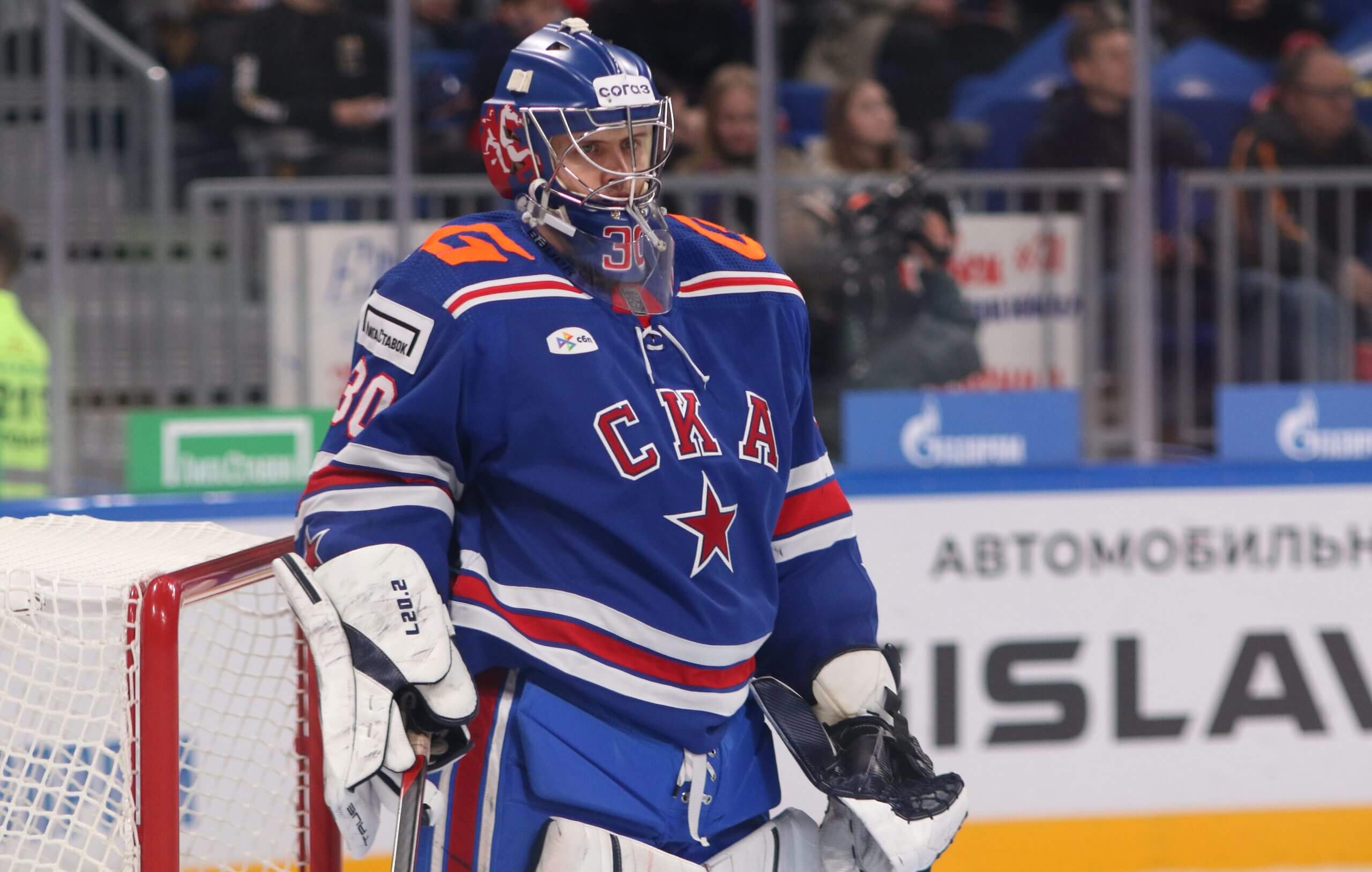

Eventually, a goalie starts to play well enough, for long enough, at enough levels that you can’t ignore the results. And it’s easier to get on board when they’re 6-foot-4, obviously. But more and more goalies in the 5-11 to 6-1 range are emerging as well, and Lindbom looks poised to be another recent success story. Three seasons ago, outside of one tough start in the bronze medal game at the World Juniors (where he was named one of the team’s top three players) against Team USA, Lindbom was tremendous, winning HockeyAllsvenskan goalie of the year and rookie of the year to backstop Djurgarden to within one game of promotion with stellar numbers. Two years ago, on loan to Färjestad so that he could play in the SHL (where he belonged), Lindbom was again good, winning the majority of the starts in a tandem with veteran Max Lagacé. And last season, his .912 save percentage was levels above every other goalie who played for Henderson as a rookie in the AHL, outperforming the more experienced Akira Schmid by a wide margin behind a bad team.
He has quick hands (a great glove hand in particular, but also a good blocker) and shoulders reacting to shots. He has quick feet. He always seems set in his stance before shots are taken. Despite his quickness, he’s not busy in the net. Few shots beat him down low because of how fast he gets in and out of his butterfly. He holds his edges well and doesn’t go down until he has to. Ultimately, he has the right blend of control and athleticism and looks like he’s on a very good trajectory for being the third-last pick in the 2021 draft. I expect him to be a dependable NHL goalie and would sooner rank him higher than lower here.
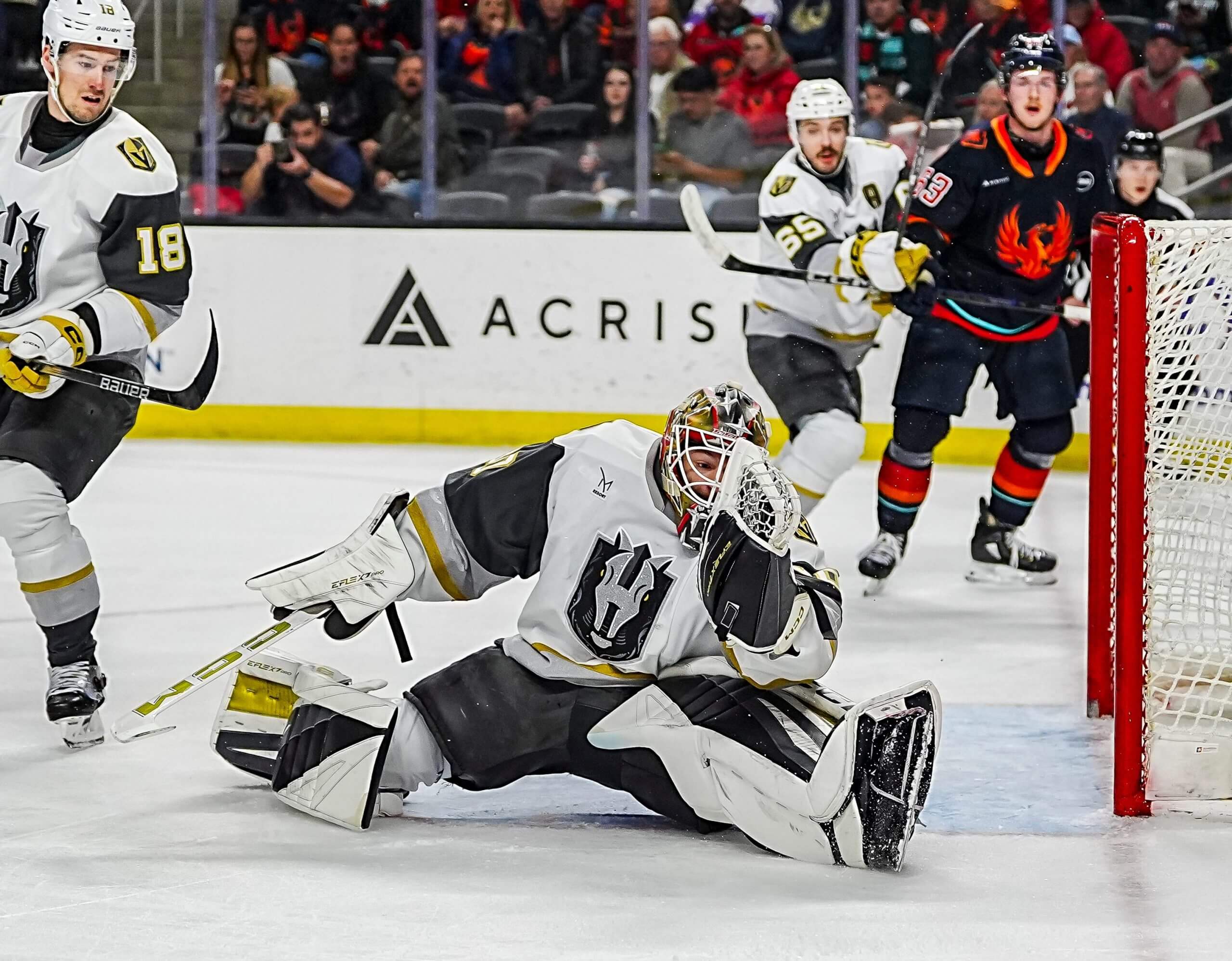

Tier 3
Dobeš was drafted in the fifth round all the way back in 2020 and has just slowly progressed and proven himself since. After climbing from U18 AAA to the NAHL the year before his draft year, he climbed from the NAHL to the USHL in his draft year. The Canadiens took a fifth-round flier on his size and ability after he stole some games in the NAHL. He then had a strong post-draft season in the USHL with Omaha and then immediately became Ohio State’s starter as a freshman, playing almost every game in his two years there and finishing his college career with a .926 save percentage across 75 games (Ohio State played a structured defensive game in front of him, but he was the team’s backbone nonetheless and one of the better goalies in college hockey as a freshman and sophomore). After a respectable first pro season in the AHL two years, he was a great story in his introduction to the NHL last year and now looks like he’s going to have a good career as a No. 2/3 goalie (in a best-case scenario he probably has a couple years as more of a 1B, too).
Dobeš is an athletic 6-foot-4 goalie who moves his 200-or-so-pound frame well post-to-post and low-to-high. But the strength of his game is positioning, where he tries to make himself look big in the net and take away a shooter’s holes by playing sharp and challenging angles designed to swallow the first shot. When he’s deep in his net, he’s also got good enough hands, reflexes, tracking and competitiveness to make stops. He’ll occasionally get beat under his arms and let a squeaker in, but Dobes checks a ton of boxes and has played quite consistently over the years.
Photo:
Eric Bolte / Imagn Images
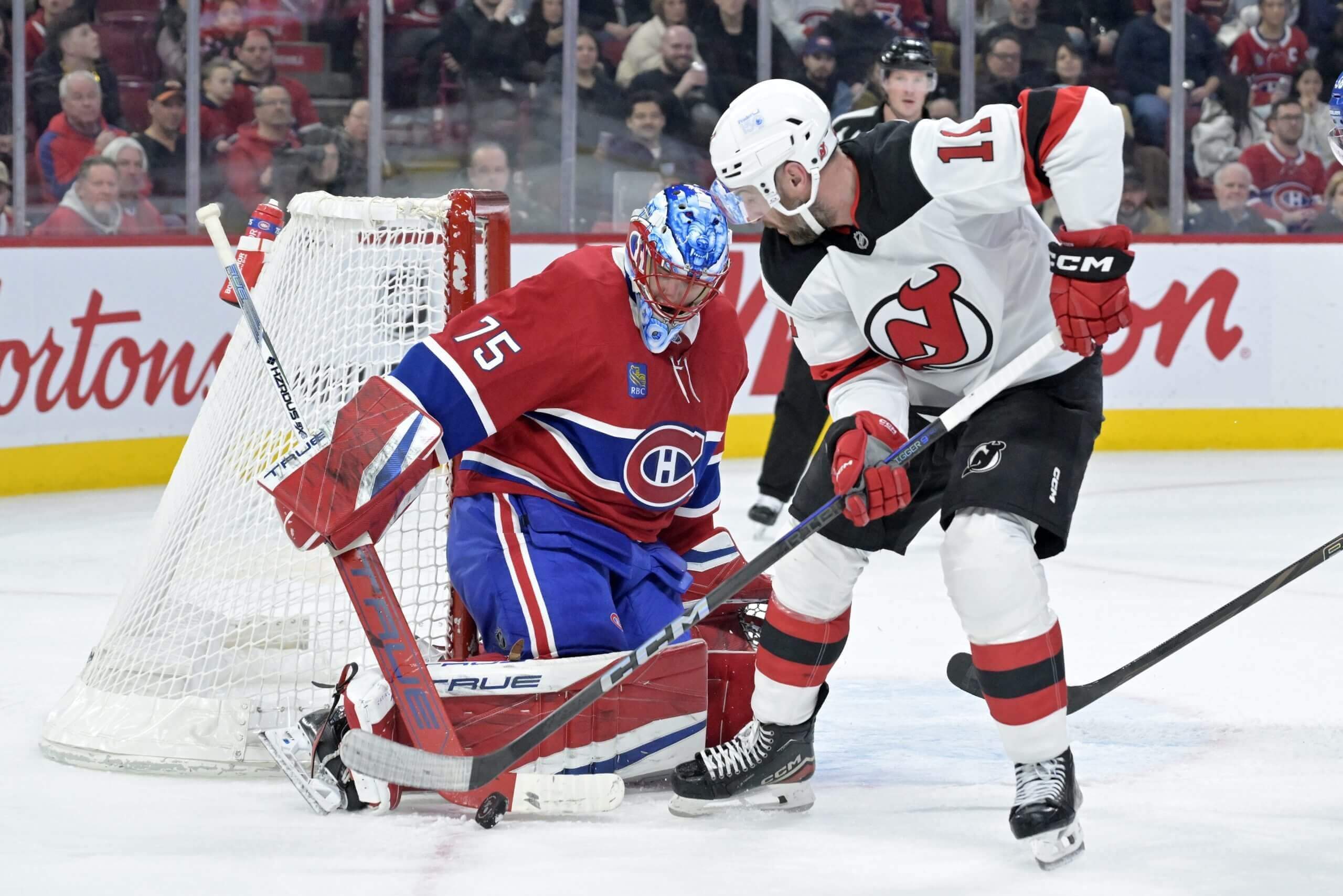

NHL Central Scouting’s No. 2-ranked North American goalie, Beckman is a late August birthday and was outstanding for Baie-Comeau across an impressive 63-game workload between the QMJHL regular season and playoffs last year. Across two QMJHL seasons now, the 2023 second-round pick of the Drakkar now has a .917 regular season save percentage and a .921 in the playoffs. He also started against Latvia and came in against Norway for Canada at U18 worlds, stopping 21 of 22 between the two.
Beckman isn’t big, but he certainly doesn’t look small in the net, with an ability to play challenging angles, take away a shooter’s options and make the first, second and third saves. He’s athletic and quick on his feet, without sacrificing his positioning and control, with an ability to make low-to-high or post-to-post saves, but not a reliance on that. He’s good technically, has good hands and is comfortable playing the puck as well. He’s also got impressive composure and seems to really be dialed in mentally. I would have drafted him a round earlier than he went (in the third instead of the fourth).
I did debate close to 10 other goalies at No. 20 here, so his spot on this list was written with pencil more than pen, but I like him.
Photo:
Steven Ellis / Daily Faceoff
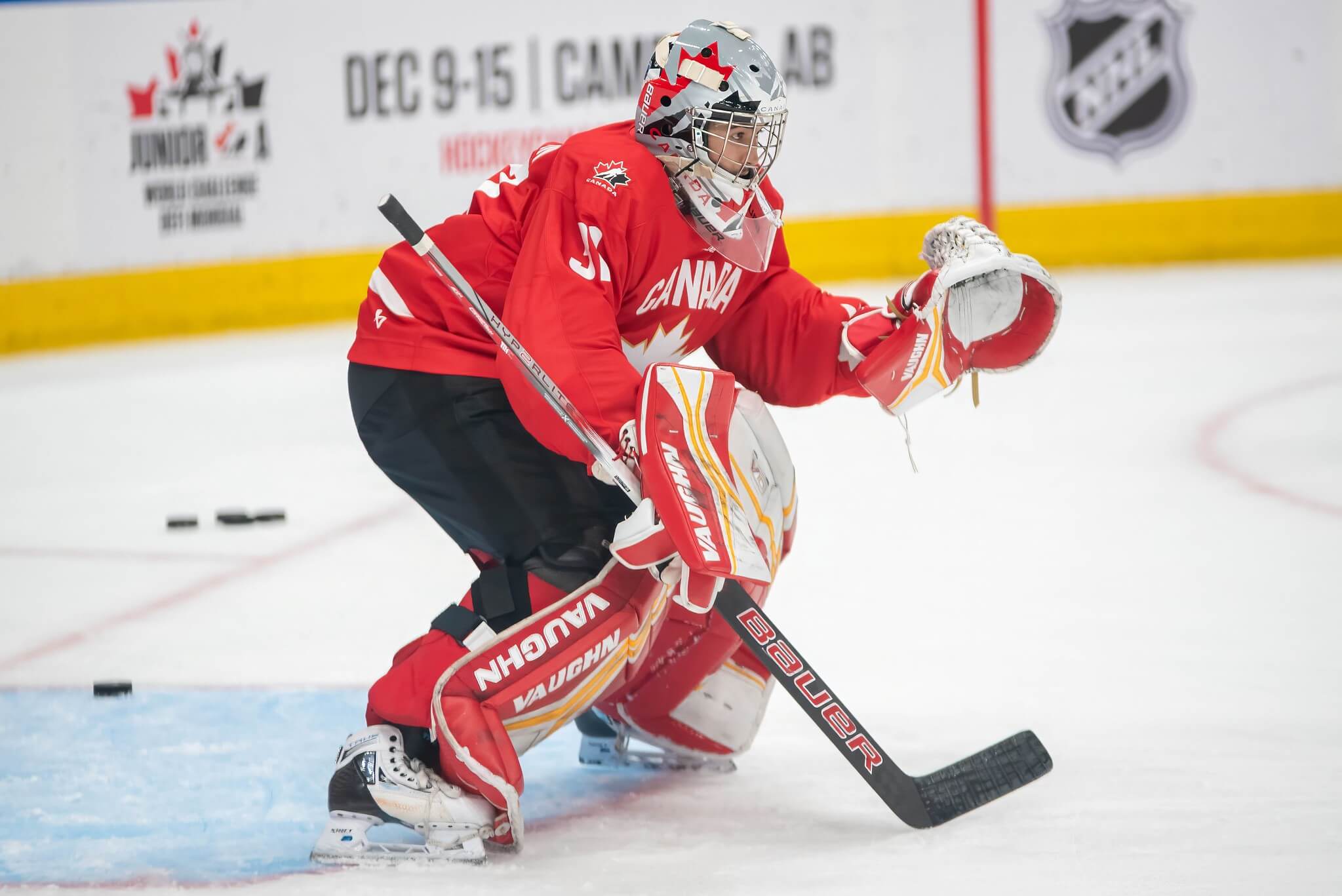

(Illustration: Demetrius Robinson / The Athletic; photos: Jeff Chiu / AP Photo, David Kirouac / Icon Sportswire / AP Photo, Minas Panagiotakis / Getty Images)

